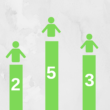With so many innovations in the B2B world, many sales and marketing people find it difficult to accurately target – or engage with – their ideal buyers. For example, prospecting is quoted to be the number 1 challenge by marketers due to a lack of integrative tools, lack of insights into their customer, lack of access to valuable sales triggers etc.
To be able to target accurately and with ease, it is important for salespeople and marketers to know the different types of B2B data available to them. To this end, we’ve compiled a brief guide to various types of data and how it can be used to support sales and marketing efforts.
There are namely 6 types of data needed to build sales and marketing campaigns – account data, technographics data, firmographics data, intent data, engagement data and contact data (aka the enabler).
Let’s dive into the specifics of each and how they can be used for effective lead generation at scale.
Update: Here’s an Infographic to read on the go!
Account Data
Identifying accounts based on your ideal customer profile is the first step in initiating any outbound campaigns (or even certain aspects of inbound). Account data includes the companies or ‘accounts’ that you are planning to target, including high value accounts, your next best ideal customers etc. Most importantly, account data includes any and all information around an account that can help you classify the companies on your list and see if they are ready for your product/service. It is also important to note that account often overlaps with other data types such as Firmographics, technographics etc. For the sake of clarity, our analysts at Cloudlead group some basic fields into the Account data category.
Basic examples of account data include:
- Company name
- Employee size
- Website traffic
- Recent funding
- Recent hiring
- Company’s social media accounts
- Paid ads, keywords
- Recently published content etc.
Common sources of account data include the usual suspects – LinkedIn, Angel List and other such platforms, business forums e.g. Inc. Verified Businesses and B2B data providers such as Cloudlead.
Firmographic Data
Firmographic data includes basic business information or characteristics which help you categorize accounts (companies) that are a good fit for you. As demographics are to people, firmographics hold the same importance for businesses for their marketing and sales efforts.
In short, firmographics include basic information on businesses such as: industry, employee size, SIC codes, sales etc. With the help of firmographic data, you can easily identify sales triggers and buying cycles on your target accounts because you understand the company and industry. For example, if you know that you’re targeting startups who have just raised a funding round, you know they’ll be on the lookout for tools to expand on their sales and marketing efforts – or product development. Since you know your product best, you will also know if you are in a position to help them ‘scale’ (the magic word for any tech startup really).
Segmenting a market and defining firmographic attributes has the following benefits:
- Business Insights – It enables in uncovering business insights to B2B target markets by answering commonly asked questions, such as:
- How many employees do the employ?
- In this target market, where the firms that are located geographically?
- What is the value of each business?
- Categorization of marketing strategies – Firms can be categorized in target markets by industry types. For instance, government entities and educational organizations have entirely different defining attributes. However, these firms are sold and marketed differently.
- Optimizing Marketing Strategies – Sending the right message at the right time to the right people.
- Understanding trends in data – Evaluating analytics and reports from segmented markets allows in recognizing trends in data. These trends help in boosting up the efficacy of marketing and sales.
Firmographic data hence includes the following:
- Company size
- Industry
- Employee size
- Office location(s)
- SIC Code
- Zip Code
- Growth trajectory
- Website ranking
- Website traffic
- Social accounts/no of followers etc.
This information can be mined from a number of open resources such as Angel List, LinkedIn, annual reports, industry reports etc. however, keeping in mind that its extremely time consuming, third party vendors like Cloudlead can deliver all this information to you in half the time.
Technographic Data
Simply put, technographic data includes the technologies that your target accounts/companies are using such as:
- Google Analytics
- SAP
- Salesforce
- Marketo
- Technology history
- Recently added technologies etc.
Often, technographic data also includes the technologies that your prospects are looking to buy. According to Business Insider, companies are estimated to spend over $3.7 trillion on tech in 2018 – this alone makes technographic data extremely important for your targeting and outbound efforts. Furthermore, with technographic data, you can better understand the technologies which best compliment your product or services. For example, if your product pairs well with Salesforce users, you can target high value accounts that use Salesforce and up your chances of acquiring a customer.
Here are some benefits of utilizing technographics in your outbound efforts:
- More informed sales conversations – Providing valuable insights by understanding what technologies a company is using. Sales representatives can use this information to tailor conversations and sales pitches.
- More targeted prospecting – To successfully target qualified prospects, you must thoroughly understand your buyers. Technographics can enhance your buyer personas by analyzing the technology stack of your prospects.
- Improve Close rates – More targeted prospecting plus informed sales conversations equal better leads and higher close rates.
This type of data can be found through multiple sources such as Builtwith, social media, forums etc. Combine technographic data with firmographic data to ensure that you are targeting the right accounts, at the right time. To further ensure that your data is fresh and save time, you should look into tools like Cloudlead.
Intent Data
Intent data analyzes the intent of the contacts at your target accounts. Simply put, intent data helps in highlighting where a prospect is in the buyer journey and if they are a good lead-to-account fit. Both firmographic and technographic data helps you filter out accounts while intent data tells you the behavior of the people behind these accounts.
Intent data includes the following:
- Topics or keywords that your target accounts/contacts are currently searching for
- Ad clicks
- Social media participation etc.
Intent data providers like Cloudlead, Bombora etc. can provide these valuable insights into your target accounts or existing B2B database – without the hassle of having to hunt through different forums, social platforms etc.
Engagement Data
Think of engagement data as tracking how your prospects think, where they are in their buying journey and how they react to different types of communication by you. This is a step further then intent data as it records how engaged your target accounts are with your marketing and sales efforts right now. Engagement data includes:
- Previous sales
- Account activity levels
- Existing connections with the account, etc.
The most common source of this data is right under your nose – your CRM! Other potential sources include LinkedIn to track account and sales rep activities, executive engagement with your content, web analytics etc.
While this type of data can be the hardest to read and analyze, Cloudlead can help you evaluate and estimate if the account is a good fit for your product now.
Contact Data
This is the main meat – think of contact data as the enabler or the actual information that lets you contact the people behind the accounts on your list. Contact data includes the following information:
- Contact name
- Job title
- Email address
- LinkedIn account
- Other social media accounts
- Direct dials
With the help of contact data, you can create tailored campaigns to target the individuals behind accounts. For example,
Common sources of contact data include LinkedIn, social media platforms, forums etc. However, this information is typically scattered and so third party tools like Cloudlead, Hunter.io, Clearbit etc are great for mining this type of data.
Takeaway
While B2B data can be broadly categorized into these 6 categories, the secret of any successful (outbound or inbound) campaign is combining information from across these groups. For example, while contact data, account data and firmographic data are the primary building blocks of any marketing or sales campaign, adding technographic data and intent data into the mix can help you target more accurately. Most importantly, combining these data types can allow you to deliver highly personalized content to your prospects – at scale!
What this essentially means is that you don’t have to spend hours tailoring your campaigns – with the help of B2B data, you can treat hundreds and thousands of accounts the way you would treat your top 1% accounts.
For help with lead generation or further information on B2B data, you can always contact our support team at hello@cloudlead.co or request a demo here.










